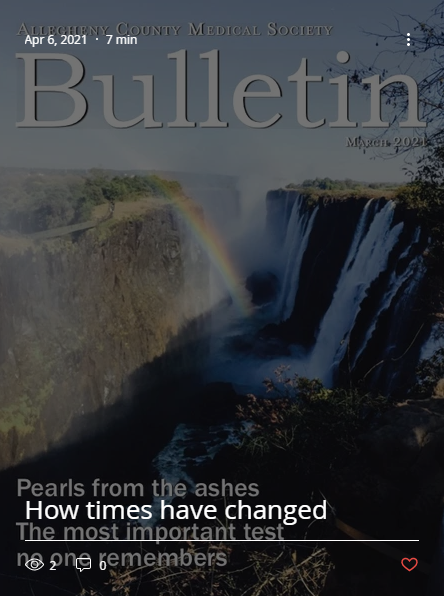
Most of us are comfortable living in the present time despite the threat of the pandemic. Many people talk about “the good old days” when life was perceived as simpler. Sometimes, however, a life-altering event invites us to think about how that event would have been managed in the past. This past July, I suddenly awoke at 3 a.m. with a burning sensation in the middle of my chest. My first impression was that it was gastrointestinal reflux. However, as I became fully awake, I realized that the burning sensation was accompanied by severe substernal chest pain. I also was aware that I had broken out in a cold sweat. I realized I was having a heart attack, and I woke my wife up so she could take me to the hospital. At that hour, with no traffic, we arrived at Allegheny General in record time, where my electrocardiogram (ECG) confirmed my diagnosis. In less than an hour of my arrival, I was in the cardiac catheterization lab where Dr. David Lasorda and his team found a completely occluded right coronary artery and significant stenosis of my left anterior descending artery. Fortunately, they were able to open both arteries and place stents across the occluded segments. Seventy-two hours later, I was discharged with an array of new medications. Three weeks later, I began cardiac rehabilitation. I am happy to report, as of this writing, that I am back to my normal activities. My blood pressure and blood lipids are now normal, and I’ve lost 20 pounds.
Medical history is one of my favorite subjects. Readers of the Bulletin will have observed that I have written several Perspective/Editorials that cover historic topics.1-6 So, it was only natural that as I was lying in the hospital recovering, that I began thinking about how my infarct would have been treated in the past.
I graduated medical school in 1967. At that time, an acute myocardial infarction (MI) was diagnosed primarily by ECG changes, supplemented by two blood enzyme tests (SGOT, SGPT). Management was empiric: six weeks of bedrest, morphine for the chest pain, Coumadin® to prevent deep venous thrombosis and pulmonary emboli and an awareness of the possibility of congestive heart failure. I remember my old chief of medicine, Dr. David Miller, saying, “If someone has an MI while milking a cow, move the cow and treat him where he lies.” Diagnostic cardiac catheterization was introduced in the 1940s to look for congenital abnormalities as well as valve issues. However, coronary angiography, introduced in the 1960s, was still a rare procedure. It wasn’t until almost two decades later that selective catheter-based interventions were widely used.7
The 1970s began an era in advancements in imaging, vascular intervention, drugs and surgery for diagnosing and treating heart and other vascular diseases. The first breakthrough in imaging was the introduction of image intensification. This technology allowed one to perform fluoroscopic examinations without dark-adapting the eyes and was derived from the military’s use of “night vision” goggles. The concept was first proposed by two Dutch physicists in 1934, whose early attempts at creating an image tube were not successful. The first successful military night vision devices were introduced by the German Army in 1939. Thanks to espionage, this technology was used by both sides during World War II. Following the war, research continued to the present time through several generations of devices. The principle of image intensification is based on the conversion of low-level light to electrons when it strikes a photocathode. These electrons are accelerated to a high-voltage microchannel plate, where each electron causes multiple electrons to be emitted. These electrons, in turn, are drawn to a higher-voltage phosphor screen, where, upon striking the screen, they are converted back into visible light. This process is akin to what happens in an old-fashioned television tube. As mentioned above, image intensification allows us to see a fluoroscopic image on a TV monitor in the ambient light of the procedure room. Prior to image intensification, fluoroscopy required the radiologist (and cardiologist) to dark-adapt their eyes with red goggles for at least 20 minutes and then view a faint fluoroscopic image in a totally dark room. It was something I experienced as a medical student and as a radiology resident doing a locum tenens in a rural hospital and would not want to go back to (see Appendix).
Other improvements included the development of specialized catheters to not only access the coronary arteries, but also to dilate them and to place stents to hold the vessel(s) open. Furthermore, newer contrast material made these procedures safer and with fewer complications. Another interventional imaging-related procedure is the placement of an endoluminal stent graft (endograft) inside the thoracic or abdominal aorta to provide support for a vessel weakened by an aneurysm. The endograft is a fabric-covered tube, surrounding a mesh metal cylinder (or stent). Endografts have reduced the need for surgery to repair aneurysms.
The pharmaceutical industry also has produced new drugs to treat patients who have suffered an MI. The two most common categories are anticoagulants and anti-cholesterol drugs. The anticoagulants are given to those patients who have had a stent placed or who are at risk of venous thromboses. These drugs come in two classes: those that block blood-clotting proteins (apixaban [Elequis®], dabigatran etexilate [Pradaxa®] and rivaroxaban [Xarelto®]) and those that decrease platelet stickiness (Ticagrelor [Brilinta®]]). These drugs have mostly replaced warfarin (Coumadin®). Anti-cholesterol agents include two classes: the statins (atoravastatin [Lipitor®], rosuvastatin [Crestor®]) which slow the production of cholesterol in the body by blocking the HMG-CoA reductase enzyme in the blood, and Exetimbe (Zetia®) which prevents absorption of cholesterol from the intestines. In addition, there are now several new drugs to treat some of the complications of an acute MI, namely congestive heart failure and arrhythmias.
Surgery also has evolved in the last 50 years, becoming safer and, in some cases, less invasive, such as percutaneous valve repair. Most significant, open-heart surgery has seen a significant decrease in morbidity and mortality as a result.
At the beginning of this Editorial, I mentioned that people often talk about the “good old days” when life was thought to be simpler and less complicated than today. Sixty years ago, the U.S. population was a little less than 190 million. Today it is 313 million. The average life expectancy was 70 years. Today it is 82. A recent report on “60 Minutes” mentioned that a baby born today could expect to live to 100 or more years. Much of that increase in lifespan is the result of the advances in medical science including the development of new drugs. In 1961, the Dow Jones hit a high of 767. Today it is hovering around 30,000. Federal spending in 1961 was about $112 billion and the national debt was $310 billion. Today the federal budget is $4 trillion, and the national debt is close to $20 trillion and rising as you read this. Also in the early 1960s, a first-class stamp was five cents. A gallon of gas was $.30; a dozen eggs was $.55; and a gallon of milk was $.49.
Every generation has its crises. In the early 1960s, the biggest concern of most people was the fear of a nuclear exchange with what was then known as the Soviet Union. I remember a fraternity party in October 1962, the time of the Cuban Missile Crisis. The theme for that party was Valentine’s Day, chosen because we weren’t sure we would be around to see the real Valentine’s Day a few months later. Today our main concerns are global: the COVID-19 pandemic, international terrorism, climate change and the possibility of global economic collapse. I certainly would not want to go back to that time.
I consider myself fortunate on many counts. First and foremost, I am grateful that my MI was not fatal. Second, I am fortunate to have been able to receive medical care and follow-up based on the fruits of the evolution in treating cardiac disease. And finally, I am grateful that because of modern medicine, I have been able to resume my normal life, modified, of course, by changes in diet, improvement in my exercise program and weight control.
Appendix: “Red goggle” fluoroscopy
My first experience with “red goggle” fluoroscopy was during a clinical rotation my third year of medical school. We had ordered a chest fluoroscopy to determine if a nodule seen on a chest x-ray on one of my patients was in the lung. Our team trooped down to the radiology department, where we were given a heavy lead apron and a pair of red goggles. We were led into the fluoroscopy room, which was pitch black. Dr. George Alker, the radiologist, began the exam and was pointing out that the “nodule” we had seen on the chest x-ray was, in fact, an osteochondroma on the scapula. As he demonstrated the findings, he asked my clinical colleagues, “You see that?” They all said yes.
“How about you, Dr. Daffner?”
“Dr. Alker, I don’t see squat!” I replied.
“Son, you need to take your goggles off.”
I had no idea the goggles were to let our eyes dark adapt. In my naivety, I thought the goggles were necessary to see the image on the fluoroscopy screen.
Six years later, older and wiser, I was doing a locum tenens for a solo radiologist in a small rural hospital in eastern North Carolina. The first day I was called to his private office across the street from the hospital to perform an upper gastrointestinal exam. To my dismay, his office had old-fashioned fluoroscopy, while the hospital had image intensification. I put on the red goggles and waited a half hour before I went into the fluoroscopy suite. Again, the room was nearly completely dark. However, when I stepped on the fluoroscopy pedal, I couldn’t see anything. So, I put my goggles back on and went out to dark adapt for another 30 minutes. The second attempt at the exam proved just as frustrating as the first. Once again, I put my goggles on for another half an hour. They say that “the third time is the charm.” And sure enough, on my third attempt to do the exam, I could see the patient’s anatomy on the fluoroscopy screen. I had the patient swallow some barium and watched it pass into the stomach. And then, the image of the barium was lost, and I frantically moved the screen to find it. I saw a dark curvilinear structure and said to myself, “Aha, the duodenal bulb.” I took four spot films and instructed the technologist to give the patient more barium and get her overhead films. A few minutes later, the tech brought in the spot film, dripping wet (they didn’t have automatic film processing). Instead of the duodenal bulb, I had taken four pictures of the right femoral head! Fortunately, the overhead films showed everything to be normal. That was my last experience with old-fashioned fluoroscopy.
References
1. Daffner, RH. Lessons from the dinosaurs. ACMS Bulletin August 2016, 294-295. 2. Daffner, RH. Whither the art of medicine. ACMS Bulletin September 2016, 326-327. 3. Daffner, RH. Game changers. ACMS Bulletin February 2019, 41-43. 4. Daffner, RH. Roentgen and the discovery that changed medicine. ACMS Bulletin November 2020, 331-334. 5. Daffner, RH. Rightly forgotten. ACMS Bulletin December 2020, 373-375. 6. Daffner, RH. Disruptive technology. ACMS Bulletin January 2021, 9-11. 7. Bourassa, MG. The history of cardiac catheterization. Can J Cardiol 2005; 12:1011-1014.

